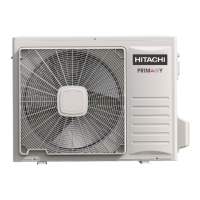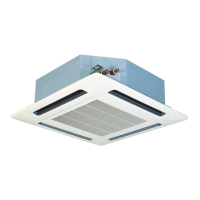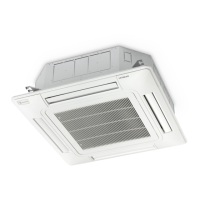Do you have a question about the Hitachi RCI-5.0FSN3 and is the answer not in the manual?
Covers installation and operation procedures for SET FREE Series FSXN1E and FSXNH(E) units.
Outlines publication rights, continuous improvement policy, and responsibility for errors.
Provides guidance on model identification, prior checks, and classification of outdoor units.
Instructions to check model name, system type, codes, and included manuals before installation.
Details the classification system for outdoor unit models based on type, capacity, and special features.
Lists combinations of outdoor units for the FSXN1E series and their power ranges.
Lists combinations of outdoor units for the FSXNH series and their power ranges.
Explains symbols (DANGER, CAUTION, NOTE) used to indicate safety-related information and instructions.
Explains symbols (DANGER, CAUTION, NOTE) used to indicate safety-related information and instructions.
Provides further safety guidelines regarding potential hazards, electrical safety, and installation precautions.
Details safety devices related to pressure vessels and high-pressure switches within the air conditioning unit.
Explains the manual's purpose, emphasizing the need for qualified personnel and adherence to instructions.
Specifies the operational temperature ranges for cooling and heating modes for the system.
Introduces the types of wired remote controls available and refers to their specific manuals.
Describes various automatic functions like three-minute protection, frost prevention, defrost cycle, and overload prevention.
Lists and illustrates the main parts of the RAS-8FSXN1E outdoor unit with corresponding numbers.
Lists and illustrates the main parts of the RAS-(10/12)FSXN1E outdoor units with corresponding numbers.
Lists and illustrates the main parts of the RAS-(14/16)FSXN1E outdoor units with corresponding numbers.
Lists and illustrates the main parts of the RAS-(5/6)FSXNH(E) outdoor units with corresponding numbers.
Lists and illustrates the main parts of the RAS-(8-12)FSXNH(E) outdoor units with corresponding numbers.
Shows the refrigerant cycle diagram and lists components for RAS-(8-12)FSXN1E models.
Shows the refrigerant cycle diagram and lists components for RAS-(14/16)FSXN1E models.
Shows the refrigerant cycle diagram and lists components for RAS-(5/6)FSXNH(E) models.
Shows the refrigerant cycle diagram and lists components for RAS-(8-12)FSXNH(E) models.
Provides guidelines and precautions for safely transporting the outdoor unit, including fastening and protection.
Offers precautions for handling the unit with fork-lift trucks to prevent injuries and damage.
Details the correct method for lifting the unit, including sling placement and safety warnings.
Provides center of gravity data for various outdoor unit models to aid in safe lifting.
Specifies ideal locations and conditions for outdoor unit installation, considering sunlight, noise, and access.
Details required clearances around the unit for installation, maintenance, and airflow.
Provides installation guidelines based on surrounding wall configurations (two, three, or four directions).
Specifies installation clearances when adjacent to buildings in two directions.
Specifies installation clearances when adjacent to buildings in three directions.
Specifies installation clearances when surrounded by buildings in four directions.
Discusses factors influencing installation dimensions, such as temperature and airflow requirements.
Covers requirements for foundations and anchorage, including drainage and bolt positioning.
Details foundation requirements, including height, drainage, and materials, with safety warnings.
Illustrates the position and specifications for securing anchorage bolts to the outdoor unit base.
Provides guidelines for selecting correct refrigerant pipe sizes based on the system type and outdoor unit capacity.
Explains how to select pipe sizes for heat pump and heat recovery systems, including cautions on using incorrect sizes.
Details specifications for copper pipes, including diameters, thickness, supply, and insulation requirements.
Lists pipe connection kits for FSXN1E series (2 pipes) and their dimensions.
Provides diagrams and dimensions for pipe connection kits for FSXN1E series (3 pipes).
Outlines precautions for installing outdoor units in combinations, including order of installation and pipe placement.
Specifies the order for installing multiple outdoor units based on capacity to ensure proper operation.
Details considerations for installing refrigerant pipes between outdoor units, including oil recovery and tilting.
Covers general guidelines for installing refrigerant pipes, including material, diameter, and insulation.
Explains the procedure for making flared connections, including torque specifications and cautions.
Describes the importance and methods for insulating refrigerant pipes to prevent heat loss and condensation.
Provides connection diagrams and pipe size specifications for heat pump and heat recovery systems.
Details pipe sizes for base outdoor units in heat pump and heat recovery systems.
Lists pipe sizes for 2-unit combinations of FSXN1E and FSXNH(E) outdoor units.
Provides pipe sizes for combinations of FSXN1E base units in heat pump and heat recovery systems.
Provides pipe sizes for combinations of FSXNH(E) base units in heat pump systems.
Lists pipe sizes for 3-unit combinations of FSXN1E and FSXNH(E) outdoor units.
Details pipe sizes for 4-unit combinations of FSXN1E outdoor units.
Provides pipe size specifications for heat recovery systems with 3 pipes.
Details the procedure and precautions for performing the air-tight test on the refrigerant system.
Explains the process of vacuum pumping the refrigerant system to remove moisture and air.
Guides the process of charging the system with additional refrigerant, including valve operation and precautions.
Provides methods for calculating and recording additional refrigerant charges based on piping and unit configurations.
Describes the automatic system for judging refrigerant amount and troubleshooting abnormal results.
Step-by-step instructions for performing the refrigerant amount check using the automated system.
Explains the results displayed by the system (sufficient, excessive, insufficient refrigerant, abnormal termination).
Highlights critical gas concentrations and necessary measures to prevent suffocation from leaks.
Emphasizes safety regulations and calculations for permissible refrigerant concentrations in case of leaks.
Addresses condensation drainage requirements and installation of drainage kits, with safety warnings.
Explains the need for drainage due to condensation and guidelines for selecting unit location and kits.
Provides general precautions and safety guidelines for electrical wiring work on the units.
Lists essential checks before and during electrical wiring, including voltage, supply lines, and earth connections.
Details how to connect power sources to outdoor and indoor units for heat pump and heat recovery systems.
Wiring diagram and component list for connecting power supply to heat pump systems.
Wiring diagram and component list for connecting power supply to heat recovery systems.
Specifies minimum wire sizes for power source and transmission cables based on unit model and power supply.
Lists electrical data and recommended breaker sizes for each outdoor unit.
Details voltage requirements, including service voltage, start-up voltage, and imbalance.
Provides information on system impedance (Zmax) and compliance with EMC directives.
Addresses harmonic compliance with IEC standards and power supply requirements.
General instructions for connecting electrical wiring to the outdoor unit terminal board.
Guides the connection of indoor units, CH units, and outdoor units via communication cables and power lines.
Explains the location and function of DIP switches on the PCB1 for unit configuration.
Details how to set external inputs/outputs and various functions of the air conditioning system.
Steps to enter and initiate the function setting mode using DIP switches and buttons.
Procedures to exit the function setting mode and return the system to normal operation.
Instructions for selecting and setting external input/output functions using the control panel.
Guides on how to select and set various operational functions via the control panel.
Lists crucial checks to perform before starting the test run, including wiring, refrigerant, and insulation resistance.
Explains how to access and use the TEST RUN mode via the PC-ART remote controller.
A checklist to verify proper operation and settings after installation and during the test run.
Lists common alarm codes, their categories, content of abnormality, and possible causes for troubleshooting.
Details the protective devices and their specifications for compressor safety, including pressure switches and oil heaters.
Provides guidance on identifying and resolving common system faults and situations not considered as faults.
| Brand | Hitachi |
|---|---|
| Model | RCI-5.0FSN3 |
| Category | Air Conditioner |
| Language | English |












